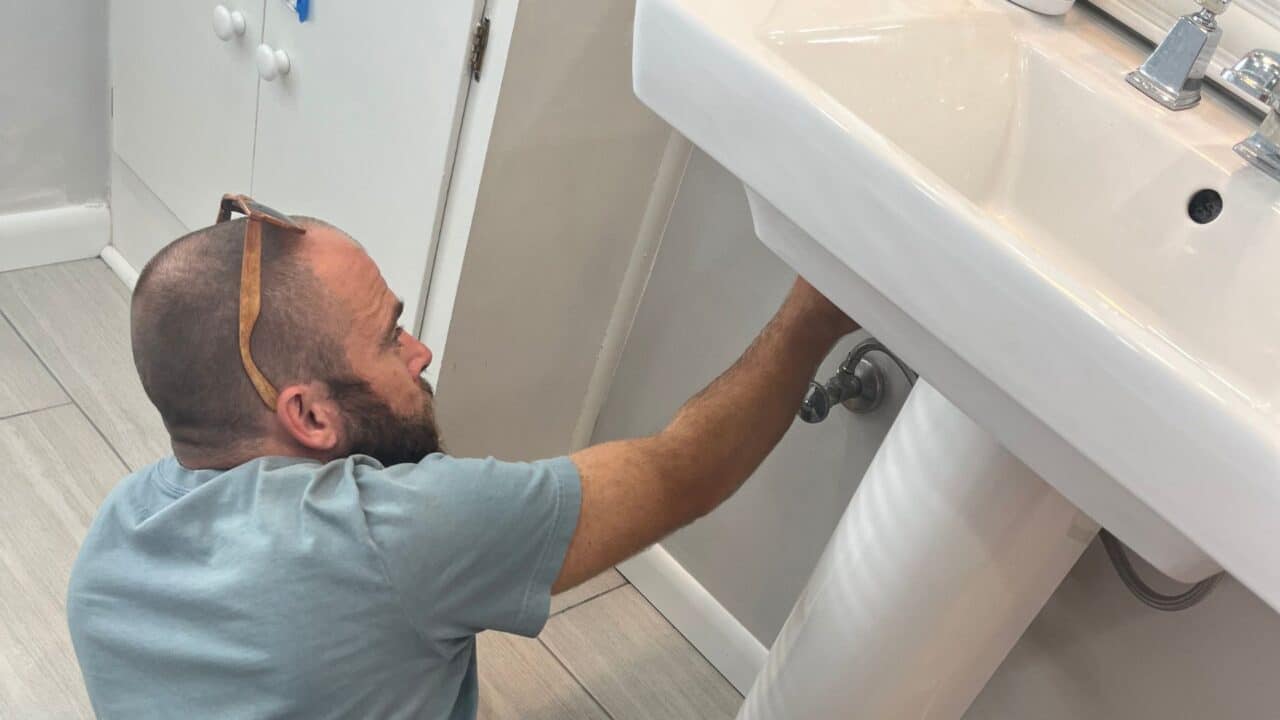What’s the Best Sheen for Bathroom Walls?
Bathrooms aren’t just another room to paint. They’re high-moisture, high-traffic, high-cleaning zones. In Northeast Ohio, we also deal with unique challenges:
- Cold winters where moisture lingers longer on walls due to lower air circulation.
- Bright summer sun that can glare off certain finishes.
- Older homes with limited ventilation or textured plaster walls.
The sheen you choose will determine how your paint handles steam, scrubbing, and seasonal light changes. Let’s compare the most common finishes so you can pick the right one for your bathroom.
Understanding Sheen: Why It Matters in Bathrooms
Paint sheen isn’t just about how shiny the wall looks — it’s about how well the surface will hold up under steam, splashes, and scrubbing. The difference comes down to the balance of resin vs. pigment in the paint:
- Higher-sheen paints (like satin or semi-gloss) have more resin. That resin acts almost like a thin layer of plastic — it seals the surface against moisture, makes the wall smoother so toothpaste and soap residue wipe off easily, and reflects more light. The trade-off is that resin also highlights wall flaws. In older Cleveland plaster bathrooms, I’ve seen semi-gloss make every bump and patch line show like a spotlight was on them.
- Lower-sheen paints (like eggshell) have more pigment. Pigment softens the look, hides uneven textures, and absorbs light so colors appear richer. That’s why eggshell looks beautiful in a Shaker Heights powder room with historic plaster. But pigment is also more porous — it soaks up moisture if ventilation is poor, which is why eggshell can peel or mildew in a steamy Lakewood full bath.
👉 Pro Tip for DIYers: If your walls aren’t perfectly smooth, stick with satin and do extra prep (spackle, sand, prime). If your walls are smooth and you want maximum durability, semi-gloss is safest — just know it will reveal any flaws you leave behind.
Sheen-by-Sheen Comparison
| Sheen | Moisture Resistance | Cleaning Ease | Appearance | Best For | Avoid If |
|---|---|---|---|---|---|
| Satin | Moderate | Good | Soft sheen, hides flaws | Older plaster, family baths with fans | Heavy scrubbing spots |
| Eggshell | Low–Moderate | Fair | Warm, velvety look | Powder rooms, guest baths | Steamy full baths |
| Semi-Gloss | High | Excellent | Bright, reflective | Kids’ baths, basements, damp homes | Walls with flaws |
Satin Finish
- Moisture Resistance: Moderate — satin handles regular steam in a master bath or upstairs bathroom as long as you have a decent exhaust fan. In winter, when windows stay closed and moisture lingers, satin will hold up if the surface is primed and sealed properly. I’ve used it in dozens of older Cleveland homes where plaster walls aren’t perfect but the owners wanted something more forgiving than semi-gloss.
- Cleaning Ease: Good — satin is smooth enough to wipe down after kids splash water from the sink or when hairspray settles on the walls. Just avoid abrasive scrub pads; a microfiber cloth and mild soap are usually enough.
- Appearance: Gentle sheen that catches just enough light to brighten the room without feeling harsh. Satin also hides more flaws than semi-gloss, which is a big deal if you’ve got patched plaster, textured walls, or uneven drywall seams.
- Best For:
-
Master bathrooms with regular steam but reliable ventilation.
-
Family bathrooms where you expect light splashes but not constant abuse.
-
Older Cleveland and Lakewood homes with plaster walls that aren’t perfectly smooth.
-
-
Watch Out: If you scrub the same spot too often with strong cleaners, satin can develop shiny “burnished” patches. DIYers often notice this around light switches and towel racks where hands touch the wall daily.
Eggshell Finish
-
Moisture Resistance: Low to moderate — eggshell looks beautiful in a powder room or half bath with no shower or tub. But in a steamy full bath, it soaks up moisture, softens, and can start to peel within a year. I’ve had clients call me back to fix mildew spots in small basement bathrooms where eggshell just couldn’t keep up.
-
Cleaning Ease: Fair — eggshell tolerates light wiping, but frequent scrubbing will wear through the pigment. Think of it as a “looks great, not made for abuse” finish.
-
Appearance: Velvety, soft texture that absorbs light, making colors look rich and warm. It’s ideal for homeowners who want a cozy, elegant vibe in a guest bath. Paired with a timeless neutral like Sherwin-Williams Alabaster, it makes a small powder room feel inviting.
-
Best For:
-
Powder rooms in historic homes where authenticity matters more than moisture defense.
-
Spaces with uneven walls where you want to hide flaws more than you need durability.
-
Guest bathrooms that see only occasional use.
-
-
Watch Out: Without top-notch ventilation, eggshell can develop mildew in corners and above showers. DIYers should avoid it in kids’ baths or basements unless they’re ready to repaint sooner than later.
Semi-Gloss Finish
-
Moisture Resistance: High — semi-gloss is the tank of bathroom finishes. It shrugs off steam and splashes, making it perfect for kids’ bathrooms, basement baths with poor airflow, or homes near Lake Erie where humidity is constant.
-
Cleaning Ease: Excellent — you can wipe off toothpaste, makeup, and soap scum without worrying about damaging the surface. It’s the go-to for bathrooms that need daily or weekly cleaning.
-
Appearance: Reflective and bright, which can make a small bath feel bigger. But that shine will also spotlight every patch, bump, or drywall seam. In an old plaster bathroom, semi-gloss can turn tiny imperfections into obvious ridges under the light.
-
Best For:
-
Kids’ bathrooms where splashes and sticky messes are a daily reality.
-
Damp basements or poorly ventilated spaces where mildew risk is high.
-
Lake Erie–adjacent homes prone to constant moisture.
-
-
Watch Out: DIYers often regret using semi-gloss on unprepped walls — every roller mark, nail pop, and patch shows once the paint dries. If you’re going semi-gloss, spend extra time sanding and priming. A Purdy White Dove roller and a quality angled brush are musts here.
Cleveland-Area Sheen Tips
- Ventilation Matters More Than Sheen Alone — Even semi-gloss will fail if steam sits on walls for hours. Install or upgrade exhaust fans, especially in winter when opening windows isn’t practical.
- Light Reflection Changes Seasonally — Semi-gloss can be a mood booster in gray winter months but may feel too shiny in summer’s bright sun. Satin offers a year-round balance.
- Lake Humidity Needs Extra Protection — If you live closer to Lake Erie, moisture issues can be constant—go semi-gloss in any full bath, no exceptions. You may also want to consider adding a dehumidifier to the room to keep the humidity regulated.
Tools & Supplies for a Professional Bathroom Finish
A good sheen still needs proper tools to look its best.
- High-Quality Roller Cover — Gives a smooth, even sheen without roller marks.
Purdy White Dove 3/8″ Nap Roller Cover - Angled Brush — Helps cut clean lines near tile and fixtures.
Wooster Shortcut Angle Sash Brush -
Painter’s Tape — Protects trim and tile for crisp edges.
ScotchBlue Original Multi-Surface Painter’s Tape -
Extension Pole — Keeps roller work smooth on high bathroom ceilings without a ladder.
Purdy Power Lock Professional Roller Extension Pole
FAQ
Q: Can I use different sheens for walls, trim, and ceilings in the same bathroom?
Yes, and in fact it often looks better. Most pros recommend satin on the walls, semi-gloss on trim and doors for extra durability, and flat or matte on ceilings to hide imperfections. This combo creates contrast, helps each surface do its job, and holds up better over time.
Q: What’s the most forgiving paint sheen for imperfect bathroom walls?
Satin is the sweet spot for older Cleveland plaster and textured drywall. It hides more flaws than semi-gloss but still resists moisture better than eggshell. If your walls have patches or seams, satin will look smoother under bathroom lighting.
Q: Will semi-gloss make my bathroom look too shiny or sterile?
It can if the entire room is painted in semi-gloss. A better approach is to use semi-gloss only in splash zones (around sinks, showers, or tubs) and balance it with softer colors or satin finishes on less exposed walls. That way, you get durability without the “hospital shine.”
Q: Is there any way to make eggshell work in a full bathroom?
Only if you have excellent ventilation and limit direct water exposure. In Northeast Ohio’s humid winters, eggshell usually fails in steamy rooms — peeling, dulling, or growing mildew. It’s best reserved for powder rooms or low-use guest baths.
Q: Do I need a special primer before painting a bathroom?
Yes — always prime in high-moisture areas. A mold- and mildew-resistant primer (like Zinsser or Kilz) helps your topcoat bond properly and prevents peeling. This step is especially important in basements or older homes near Lake Erie where dampness lingers.
Q: How many coats of paint should I use on bathroom walls?
Two coats are standard for durability and even color coverage. If you’re covering a darker color or patchy plaster, prime first and then apply two finish coats. Skipping this often leads to uneven sheen and reduced washability.
Q: What’s the best way to clean painted bathroom walls without damaging the sheen?
Use a damp microfiber cloth and mild soap. Avoid abrasive scrub pads or harsh chemicals, especially on satin or eggshell, since they can leave shiny burnished spots. Semi-gloss can take more scrubbing, but gentle cleaning will always extend the life of the paint.
Q: How do Cleveland’s winters and summers affect bathroom paint?
Cold winters trap moisture indoors, making ventilation critical — even the best sheen will fail if steam sits too long. In bright summer sun, high-gloss finishes can look extra reflective, while satin usually offers a more balanced look year-round. Matching sheen to both climate and ventilation is the key to long-term results.
Q: Painting my bathroom seems like too big of a task to DIY, can you help?
A: We would love to help anyone in the Northeast Ohio area with their bathroom painting projects!

